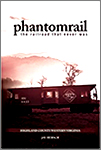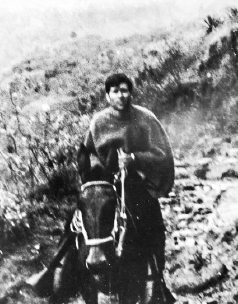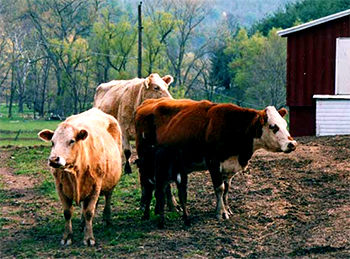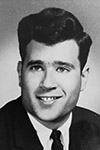The Volunteer Who Built a Railroad to the Sky — Jay Hersch (Colombia)
A Profile in Citizenship
by Jeremiah Norris (Colombia 1963–65)
Back story: Imagine the improbable
 After serving in Colombia, 1964-66, RPCV Jay Hersch buys a farm in the Western Highlands of Virginia, starts a successful business, then fulfills a long-held dream: he lays down a road bed for 155 feet of track, builds a replica of an existing Train Station, finds a surplus caboose and coal car — and from dream to reality, creates a railroad on his property! Jay’s published book, Phantomrail: The Railroad that Never Was, available on Amazon, tells the complete story.
After serving in Colombia, 1964-66, RPCV Jay Hersch buys a farm in the Western Highlands of Virginia, starts a successful business, then fulfills a long-held dream: he lays down a road bed for 155 feet of track, builds a replica of an existing Train Station, finds a surplus caboose and coal car — and from dream to reality, creates a railroad on his property! Jay’s published book, Phantomrail: The Railroad that Never Was, available on Amazon, tells the complete story.
Since his boyhood days in Chicago, Jay remembers waiting with his grandfather at the end of the Kenzie Avenue line, fascinated as he watched rail workers push the streetcar around the turnstile until it was headed back toward downtown. He also recalled counting the cars as the freight trains rumbled past and last — but not least, seeing the caboose as the symbolic end of the train. This was the foundation of Jay’s dream deferred: it was about railroads. Summer vacations spent traveling the four transcontinental routes from that “brawling city of broad shoulders and player of railroads” on such exotic beauties as the “Super Chief,” put down a seed which lay dormant for decades.

Jay Hersch riding Socrates in the High Andes circa 1965
But how did this kid from Chicago get to the High Andes in Colombia as a Peace Corps Volunteer, then to the Western Highlands of Virginia — and once there, manage to combine what he had learned about economic development from his work with farmers in Colombia with his love of railroads from his childhood?
Well, after returning home, he attended the Johns Hopkins School of Advanced International Studies. While his head was in his studies, his soul longed for the tranquility of the Andean mountains where he had spent two years organizing campesino agricultural cooperatives.
Settled in D.C., the Appalachian Mountains beckoned Jay at only a short forty-five minutes west of his urban life. He confided to his wife Pat of an abiding desire to find Colombia in America. With tent and backpacks, they went out on weekends to explore. After many nights under moon and stars, visiting mountain land, they discovered their dream and purchased a farm in Highland County, Virginia.

Beefalo
But the dream kept growing: a farm needed livestock. So, while still living and working in the Nation’s Capital, Jay partnered with the farmer renting his land to raise Beefalo cattle — a genetic hybrid cross of bovine and bison that had captured his attention in an American Airlines article read on a business trip for the Office of Economic Opportunity where he worked — and a business was born. The idea was to raise a successful breed and encourage farmers in his valley to join the enterprise and raise the rural standard of living. A Federal worker by day, an entrepreneur in his off hours. Highland Beefalo Farms morphed into Highland Beef Farms, a successful family business which thrives today.
The years passed, his family grew to three sons, and though living in Reston, Virginia, the farm remained the spiritual center of Jay’s life. Farming, cattle breeding, fence building were intermingled always with the children’s school activities — a rich balance of two worlds.
Then, on one wintry January afternoon in 1998, hiking along a crest near his mountain retreat, a vision came to life in the snow. Jay was up on a steep ridge and noticed that the tracks of his Ford-150 created an image of two sets of railroad tracks in the snowy canopy. They looked real — and real enough to germinate that dormant seed. At night, Jay began to dream of having a real train on their farm — on railroad tracks. Although a caboose and coal car would be synonymous with a train, what would they be without a train station?
Turned out, it was not such a crazy idea. A century earlier, the Highland Board of Supervisors in Virginia approved the concept of a railroad. Jay interviewed families on whose land that railroad was to have been built. True enough, county officials had offered debentures to support the project. But then the venture collapsed, leaving the county with a load of bad debt. The syndicate that promoted the railroad ran out of money and it morphed into local lore. Turns out, Hersch discovered, the historical railroad that never was would have run through his farm!
Until Jay made Don Quixote spring to vibrant life in the twenty-first century . . . not by tilting at windmills, but by making what was once his fantasy real. First, the station had to be built. He modeled it after The Washington and Old Dominion Trail Station which still can be seen today along the running path on the right of way in Reston, VA. He had that station replicated in a miniaturized version, complete with the representative contours of all railroad stations and called it: ”Highland Station,” the first and only ever in Highland County.
On creosoted soaked ties, friends came together to do the backbreaking work of laying 155 feet of track. Obtaining a caboose constituted two and a half years of frustration. Making the station, and laying tracks proved to be easy tasks by comparison. At last, a caboose was obtained from surplus property at the Norfolk Southern RR Yards in Roanoke, VA. But getting it back to his farm was a daunting problem. Once loaded onto a flat-bed trailer, the total height could not be more than fifteen feet off the ground, providing for a scant 1.5 inches of clearance under the lowest overpass on the Interstate. At one point, the caboose passed a towed, large scale yacht: a double oxymoron — a train passing a boat and both were fish out of water!
One fine day in 2003, Jay assembled the crew that had more enthusiasm than expertise in railroad construction. The caboose was lifted off the trailer, placed on the tracks alongside a coal car—and that once imagined railroad emerged into view. One could stand back at its starting point, look out to its terminus, and see how the tracks seemed to cantilever over the cow pasture River Valley below — and right into the rising slopes of Shaw’s ridge on the other side: a Railroad to the Sky!
Jay used weathered wood salvaged from an old barn as interior paneling for the caboose, put in a trundle bed for sleeping, made a kitchen in the far end, and transformed that train car into a complete lodge, replete with a sitting and social area in the bay. Literally, it became his home away from home, a place where he could contemplate and quietly renew.

Jay Hersch
The Railroad to the Sky is an elegy for a time remembered now more with nostalgia and longing, before people could travel at sub-sonic speeds while text messaging to other information-laden recipients in far corners of planet earth. It is commensurate with a child’s unconfined horizons to wonder and then one day to turn an enthrallment into form and substance. Jay can sit at his caboose’s eastward porthole, look out as he once did long ago on the “Golden” wending its way through the Nebraska prairie, and see his own cattle grazing amidst verdant pastures. Out beyond, there is an almost visible softness in the rising mist which often blurs contours of the Shenandoah Mountains, those craggy, commanding heights that first drew his passion for lore to the Western Highlands. By using rails as the connection from youth to adulthood, he made the impossible dream of childhood come true. In the bargain, the county finally got its Highland Shenandoah Western Virginia Railroad, if a bit late by more than a century.
In using his post Peace Corps days with residents in the Western Highlands of Virginia to wonder and imagine — then to act, Jay Hersch has physically demonstrated that –“Impossible Dreams” can be realities, earning him a well-deserved Profile in Citizenship.
Jerry:
A very well-written, informative profile. I had no idea about Jay.
What a great story. I’ve known jay since peace corps day and didn’t know all this about him. Thanks for writing this
What a wonderful reminiscence with his past that Gwen and I have shared with Jay and Pat, their children and ours over the last 50 years since Peace Corps. We were all there when the iron tracks were bent to conform to the hill and the dream, laid on top of the planks, fastened, and made ready for the caboose. We pitched in to help over the months…don’t recall what we did. But fetching the caboose from Roanoke and laying it down on the tracks was an indescribable emotional moment for all of us. I think the Beefalo even bellowed out cheering “mooos”..
Wonderful story and eloquent writing. I learned things about Jay I did not know.
Jay,
What a wonderful and fascinating life you have lived. I think Kevin Costner could play you in the movie. It puts
“Field of Dreams” in the correct category of a dream but your life is for real. You are an inspiration to all of us that
believe there are no limits to what we can achieve and to the youth of the world that need to hear this message.
My very best to you and your family.
Mike Wolfson
Peru Coop group that trained with your group at Cal State in LA.
Great story. I only faintly remember Jay from the few days in Bogota when he and his group arrived to replace our group. Whatever he accomplished in his two years in Peace Corps, it’s obvious he’s accomplished much in the years following. Congratulations, Jay!
Jay,
Fascinating reading about you Railroad to the Sky, and the beefalo. I also note that you worked for the OEO. I did also, in the Atlanta office in 1967. You have had a wonderful life.
Ken Oehlkers
Peru Coop group that trained with your group at Cal State in LA, now living in San Miguel de Allende, Mexico
Great story and explains why the family needed Pat to write A Tribe Apart to exploit me. Because you couldn’t support your family with your stupid visions.